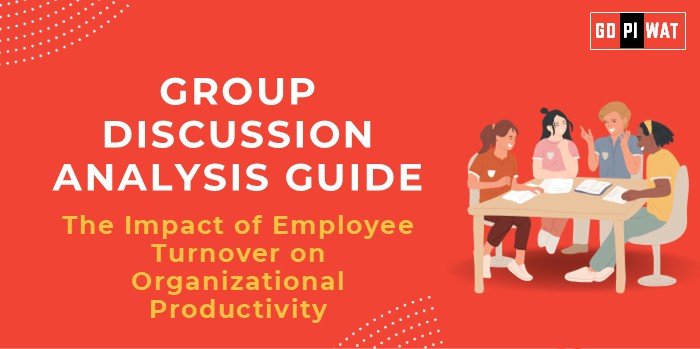📋 Group Discussion (GD) Analysis Guide: The Impact of Employee Turnover on Organizational Productivity
🌐 Introduction
- 📌 Opening Context: Employee turnover significantly affects organizational productivity, posing challenges such as disrupted workflows and increased hiring costs.
- 📌 Topic Background: Turnover, often influenced by factors like job satisfaction, leadership, and market competition, is a key metric for HR performance. Recent trends show organizations investing heavily in retention strategies amid growing competition for talent.
📊 Quick Facts and Key Statistics
- 🌍 Turnover Rates: The global average is 10-15%, with technology sectors seeing up to 25%.
- 💸 Cost of Turnover: Replacing an employee costs 33% of their annual salary (Society for Human Resource Management).
- 📉 Impact on Productivity: Companies with high turnover rates experience 20-25% lower employee morale and productivity.
- 📈 Retention Investments: Companies spending 10% more on employee engagement saw a 5% decrease in turnover rates (Gallup).
🤝 Stakeholders and Their Roles
- 👩💼 Employees: Seek career growth, job satisfaction, and a positive work environment.
- 🛠️ Management: Responsible for creating retention strategies, fostering a supportive culture, and providing growth opportunities.
- 📋 Human Resources (HR): Implement recruitment, onboarding, training, and development programs to reduce turnover.
- 🌐 External Entities: Recruitment agencies and competitors influence job-switching trends and the availability of talent.
🏆 Achievements and ⚠️ Challenges
Achievements
- 💡 Enhanced Retention Programs: Companies investing in employee engagement have reduced turnover by 25-59%.
- 📆 Flexible Work Arrangements: Implementing flexible schedules has led to a 15% improvement in retention rates.
- 📈 Career Development Opportunities: Organizations offering clear career progression paths have seen a decrease in turnover.
Challenges
- 💸 High Replacement Costs: The financial burden of replacing employees includes recruitment, training, and lost productivity.
- 📚 Loss of Institutional Knowledge: Departing employees take with them valuable experience and insights.
- 📉 Impact on Morale: Frequent turnover can lead to decreased morale and engagement among remaining staff.
🌍 Global Comparisons
- 🇯🇵 Low Turnover Example: Japan maintains a low turnover rate due to cultural emphasis on long-term employment.
- 🇺🇸 High Turnover Example: The U.S. retail sector experiences turnover rates exceeding 60%, highlighting industry-specific challenges.
📖 Case Studies
- 🎯 Zappos: By fostering a strong company culture, Zappos achieved a 75% employee retention rate over five years.
- 💻 Infosys: Implemented reskilling initiatives that reduced turnover by 10%.
💡 Structured Arguments for Discussion
- Supporting Stance: “High employee turnover disrupts organizational productivity and incurs significant costs.”
- Opposing Stance: “Some level of turnover is beneficial, bringing in new skills and perspectives.”
- Balanced Perspective: “While excessive turnover is detrimental, a moderate level can stimulate innovation and adaptability.”
🗣️ Effective Discussion Approaches
- 📊 Opening Techniques:
- Present compelling statistics, such as the cost of turnover being up to a third of an employee’s salary.
- Share a relevant case study, like Zappos’ success in reducing turnover through cultural initiatives.
- 📌 Counter-Argument Handling:
- Acknowledge the benefits of new talent but emphasize the importance of retaining experienced employees to maintain stability and productivity.
📈 Strategic Analysis of Strengths and Weaknesses
SWOT Analysis
- Strengths:
- Introduction of new ideas and skills.
- Opportunity to reshape organizational culture.
- Weaknesses:
- High financial costs associated with turnover.
- Potential loss of critical knowledge and experience.
- Opportunities:
- Implementing predictive analytics to foresee and mitigate turnover.
- Enhancing employee engagement and development programs.
- Threats:
- Competitive job markets attracting top talent away.
- Economic downturns leading to increased voluntary turnover.
🎓 Connecting with B-School Applications
- 🌍 Real-World Applications:
- Understanding turnover dynamics is crucial for managing human capital effectively in various business scenarios.
- 📚 Sample Interview Questions:
- “How would you address high turnover in a startup environment?”
- “Compare retention strategies across different industries.”
- 💡 Insights for B-School Students:
- The role of leadership in influencing employee retention.
- Utilizing data analytics to predict and manage turnover.
📄 Conclusion
Employee turnover has a profound impact on organizational productivity. While some turnover can introduce beneficial changes, high rates are often costly and disruptive. Organizations must implement effective retention strategies, such as career development opportunities and flexible work arrangements, to mitigate the negative effects of turnover.


